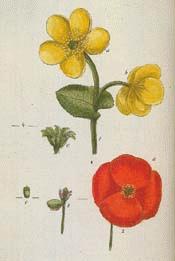
Botanical.com Home Page

|
Marigold, Marsh
(Caltha palustris LINN.)
Click on graphic for larger image
|
Marigold, Marsh
Botanical: Caltha palustris (LINN.)
Family: N.O. Ranunculaceae
---Synonyms---Kingcups. Water Blobs. Horse Blobs. Bull's Eyes. Leopard's Foot. Meadow Routs. Verrucaria. Solsequia. Sponsa solis.
---Parts Used---Whole plant, buds, leaves.
The Marsh Marigold, a showy dark-green plant resembling a gigantic buttercup, is abundant in marshes, wet meadows, and by the side of streams, where it forms large tufts or masses.
---Description---It is a herbaceous perennial. The stems are about a foot in height, hollow, nearly round, erect, but at times creeping and rooting at intervals in the lower portions, which are generally of a purple colour.
Most of the leaves spring directly from the ground, on long stalks, kidney-shaped, large and glossy. The stem-leaves have very short stalks and are more pointed at the top.
It flowers from mid-March till the middle of June, the flowers being at the end of the stems, which divide into two grooved flowerstalks, each bearing one blossom, from 1 to 2 inches in diameter. The Marsh Marigold is closely allied to various species of buttercups, but the flower has no real corolla, the brilliant yellow cup being composed of the five petaloid sepals.
The generic name is derived from the Greek calathos (a cup or goblet), from the shape of its flowers; the specific name from the Latin palus (a marsh), in reference to its place of growth.
The English name Marigold refers to its use in church festivals in the Middle Ages, as one of the flowers devoted to the Virgin Mary. It was also used on May Day festivals, being strewn before cottage doors and made into garlands.
Shakespeare refers several times to the flower, 'Winking Marybuds begin to ope their golden eyes.'
It has been called Verrucaria because it is efficacious in curing warts; also Solsequia and Sponsa solis because the flower opens at the rising of the sun and closes at its setting.
[Top]
- ---Medicinal Action and Uses---Every part of the plant is strongly irritant, and cases are on record of serious effects produced by rashly experimenting with it. Dr. Withering says:
- 'It would appear that medicinal properties may be evolved in the gaseous exhalations of plants and flowers, for on a large quantity of the flowers of Meadow Routs being put into the bedroom of a girl who had been subject to fits, the fits ceased.'
An infusion of the flowers was afterwards successfully used in various kinds of fits, both of children and adults.
A tincture made from the whole plant when in flower may be given in cases of anaemia in small, well-diluted doses.
The buds have occasionally been used as capers, but rather inadvisedly; the soaking in vinegar may, however, somewhat remove the acid and poisonous character of the buds in their fresh state.
The leaves can be cooked and eaten like spinach.
The juice of the petals, boiled with a little alum, stains paper yellow, but the colour so produced is said not to be permanent.
---Cultivation---The Marsh Marigold is propagated by parting the roots in autumn. Itshould be planted in a moist soil and a shady situation. A double variety is cultivated in gardens.
See BUTTERCUP.
Common Name Index
A MODERN HERBAL Home Page
Bear in mind "A Modern Herbal" was written with the conventional wisdom of the early 1900's. This should be taken into account as some of the information may now be considered inaccurate, or not in accordance with modern medicine.
© Copyright Protected 1995-2024 Botanical.com
|

